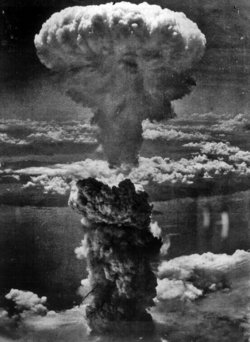News Analysis, William O. Beeman and Thomas Stauffer
01/29/06 "Pacific News Service" -- -- President Bush declared on June 25 that "we will not tolerate" a nuclear armed Iran. His words are empty. The physical evidence for a nuclear weapons program in Iran simply does not exist.
Iran is building a 1,000-megawatt nuclear power plant in Bushehr with Russian help. The existence of the site is common knowledge. It has been under construction for more than three decades, since before the founding of the Islamic Republic in 1979.
Two other nuclear research facilities, now under development, have come to light: a uranium enrichment plant in the city of Natanz and a deuterium ("heavy water") facility in the city of Arak. Neither is in operation. The only question of interest is whether these facilities offer a plausible route to the manufacture of plutonium-based nuclear bombs, and the short answer is: They do not.
The Bushehr plant is only part of the argument that Iran is embarked on a nuclear weapons program, but it is the part that can readily be analyzed. State Department accusations of dangerous Iranian intentions for the Natanz and Arak facilities are based on a patchwork of untestable, murky assertions from dubious sources, including the People's Mujahedeen (Mujahedeen-e Khalq, MEK or MKO), which the United States identifies as a terrorist organization. These sources assert that there are centrifuges for enriching uranium (an alternative to fissile plutonium for bombs) or covert facilities for extracting plutonium. Neither of these claims are especially credible, since the sources are either unidentified or are the same channels which disseminated the stories about Iraq's non-conventional weapons or the so-called chemical and biological weapons plant in Khartoum.
The testable part of the claim -- that the Bushehr reactor is a proliferation threat -- is demonstrably false. There are several reasons, some technical, some institutional.
--The Iranian reactor yields the wrong kind of plutonium for making bombs.
--The spent fuel pins in the Iranian reactor would, in any case, be too dangerous to handle for weapons manufacture.
--Any attempt to divert fuel from the Iranian plant will be detectable.
--The Russian partners in the Bushehr project have stipulated that the fuel pins must be returned to Russia, as has been their practice worldwide for other export reactors.
Just as there are many different kinds of nuclear reactors, there are different forms of plutonium, distinctions that are almost never made in public discussions of nuclear proliferation.
There are two different kinds of reactors, heavy-water or graphite-moderated reactors; and pressurized, or "light water" reactors (PWRs). The Dimona nuclear power plant in Israel is an example of the former. The Bushehr plant is the latter.
The Israeli plant is ideal for yielding the desirable isotope of Plutonium (Pu 239) necessary for making bombs. The Iranian plant will produce plutonium, but the wrong kind. It will produce the heavier isotopes, Pu240, Pu241 and Pu242 -- almost impossible to use in making bombs.
Crucial to extracting weapons-grade plutonium is the type of reactor and the mode in which it is operated. The Israeli-type plant can be refueled "on line," without shutting down. Thus, high-grade plutonium can be obtained covertly and continuously. In the Iranian plant, the entire reactor will have to be shut down -- a step that cannot be concealed from satellites, airplanes and other sources -- in order to permit the extraction of even a single fuel pin.
In the Israeli reactor, the fuel is recycled every few weeks, or at most every couple of months. This maximizes the yield of the highest-quality, weapons-grade plutonium. In the Iranian-type reactor, the core is exchanged only every 30-40 months -- the longer the fuel cycle, the better for the production of power.
For the Iranian reactor at Bushehr, any effort to divert fuel will be transparent because a shutdown will be immediately noticeable. No case of production of bomb-grade material from fuel from an Iranian-type plant has ever been reported.
No one can read the collective mind of a government. But even if Iran proves in the future to have ambitions for developing nuclear weapons, any actual production is years, perhaps decades away. Furthermore, Iran has fully acquiesced to the international inspections process. Iran is a signatory to the Nuclear Nonproliferation Treaty (NPT). On June 22, the head of the Iranian Atomic Energy Organization, Gholam-Reza Aghazadeh, reiterated that all of Iran's nuclear facilities are open for inspections by the International Atomic Energy Agency (IAEA) in compliance with treaty guarantees.
Stauffer is a former nuclear engineer and specialist in Middle Eastern energy economics. Beeman ( William_beeman@brown.edu ) is director of Middle East Studies at Brown University. Each has conducted research in Iran for more than 30 years.
Copyright © 2004 Pacific News Service
01/29/06 "Pacific News Service" -- -- President Bush declared on June 25 that "we will not tolerate" a nuclear armed Iran. His words are empty. The physical evidence for a nuclear weapons program in Iran simply does not exist.
Iran is building a 1,000-megawatt nuclear power plant in Bushehr with Russian help. The existence of the site is common knowledge. It has been under construction for more than three decades, since before the founding of the Islamic Republic in 1979.
Two other nuclear research facilities, now under development, have come to light: a uranium enrichment plant in the city of Natanz and a deuterium ("heavy water") facility in the city of Arak. Neither is in operation. The only question of interest is whether these facilities offer a plausible route to the manufacture of plutonium-based nuclear bombs, and the short answer is: They do not.
The Bushehr plant is only part of the argument that Iran is embarked on a nuclear weapons program, but it is the part that can readily be analyzed. State Department accusations of dangerous Iranian intentions for the Natanz and Arak facilities are based on a patchwork of untestable, murky assertions from dubious sources, including the People's Mujahedeen (Mujahedeen-e Khalq, MEK or MKO), which the United States identifies as a terrorist organization. These sources assert that there are centrifuges for enriching uranium (an alternative to fissile plutonium for bombs) or covert facilities for extracting plutonium. Neither of these claims are especially credible, since the sources are either unidentified or are the same channels which disseminated the stories about Iraq's non-conventional weapons or the so-called chemical and biological weapons plant in Khartoum.
The testable part of the claim -- that the Bushehr reactor is a proliferation threat -- is demonstrably false. There are several reasons, some technical, some institutional.
--The Iranian reactor yields the wrong kind of plutonium for making bombs.
--The spent fuel pins in the Iranian reactor would, in any case, be too dangerous to handle for weapons manufacture.
--Any attempt to divert fuel from the Iranian plant will be detectable.
--The Russian partners in the Bushehr project have stipulated that the fuel pins must be returned to Russia, as has been their practice worldwide for other export reactors.
Just as there are many different kinds of nuclear reactors, there are different forms of plutonium, distinctions that are almost never made in public discussions of nuclear proliferation.
There are two different kinds of reactors, heavy-water or graphite-moderated reactors; and pressurized, or "light water" reactors (PWRs). The Dimona nuclear power plant in Israel is an example of the former. The Bushehr plant is the latter.
The Israeli plant is ideal for yielding the desirable isotope of Plutonium (Pu 239) necessary for making bombs. The Iranian plant will produce plutonium, but the wrong kind. It will produce the heavier isotopes, Pu240, Pu241 and Pu242 -- almost impossible to use in making bombs.
Crucial to extracting weapons-grade plutonium is the type of reactor and the mode in which it is operated. The Israeli-type plant can be refueled "on line," without shutting down. Thus, high-grade plutonium can be obtained covertly and continuously. In the Iranian plant, the entire reactor will have to be shut down -- a step that cannot be concealed from satellites, airplanes and other sources -- in order to permit the extraction of even a single fuel pin.
In the Israeli reactor, the fuel is recycled every few weeks, or at most every couple of months. This maximizes the yield of the highest-quality, weapons-grade plutonium. In the Iranian-type reactor, the core is exchanged only every 30-40 months -- the longer the fuel cycle, the better for the production of power.
For the Iranian reactor at Bushehr, any effort to divert fuel will be transparent because a shutdown will be immediately noticeable. No case of production of bomb-grade material from fuel from an Iranian-type plant has ever been reported.
No one can read the collective mind of a government. But even if Iran proves in the future to have ambitions for developing nuclear weapons, any actual production is years, perhaps decades away. Furthermore, Iran has fully acquiesced to the international inspections process. Iran is a signatory to the Nuclear Nonproliferation Treaty (NPT). On June 22, the head of the Iranian Atomic Energy Organization, Gholam-Reza Aghazadeh, reiterated that all of Iran's nuclear facilities are open for inspections by the International Atomic Energy Agency (IAEA) in compliance with treaty guarantees.
Stauffer is a former nuclear engineer and specialist in Middle Eastern energy economics. Beeman ( William_beeman@brown.edu ) is director of Middle East Studies at Brown University. Each has conducted research in Iran for more than 30 years.
Copyright © 2004 Pacific News Service







No comments:
Post a Comment